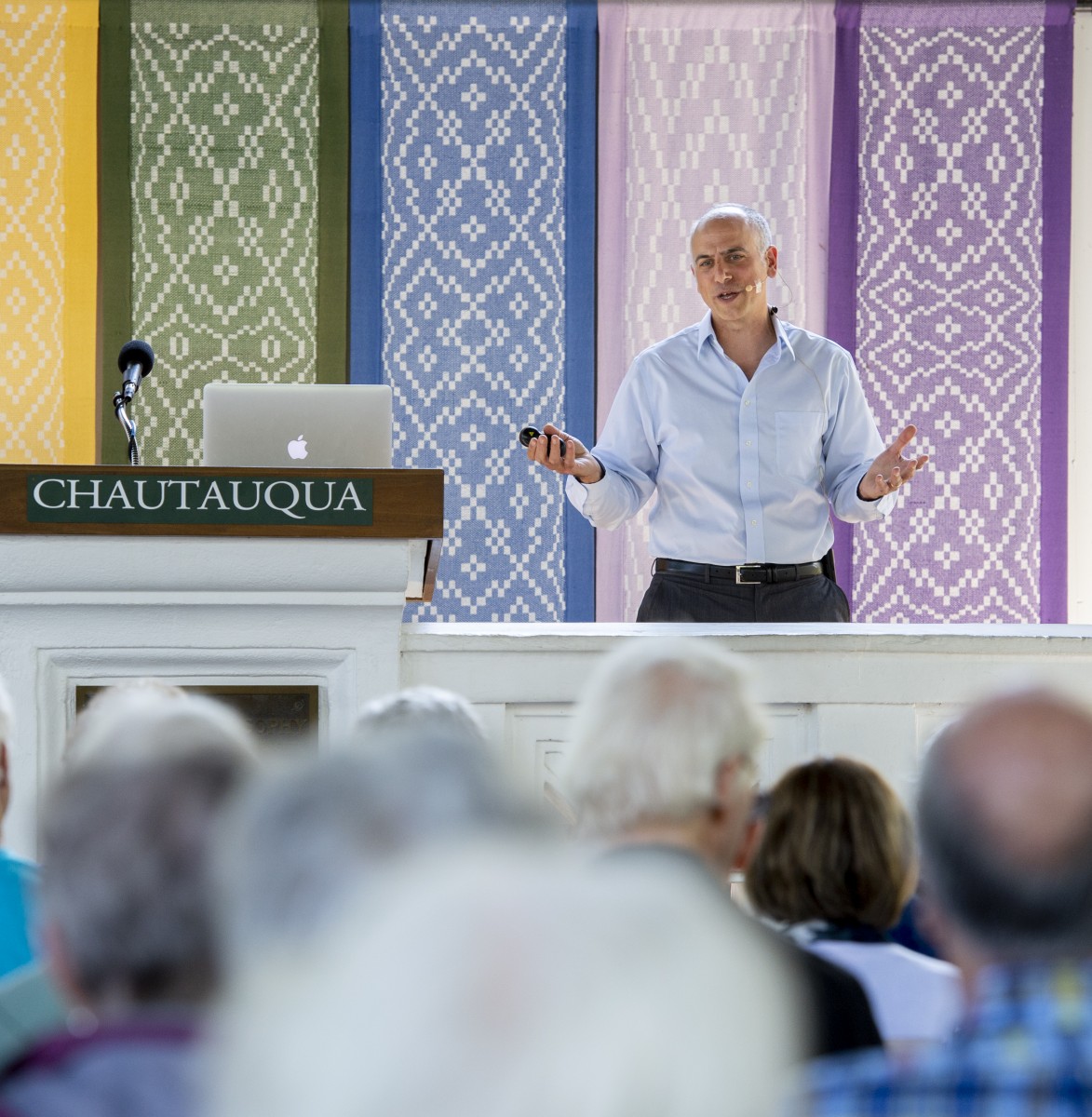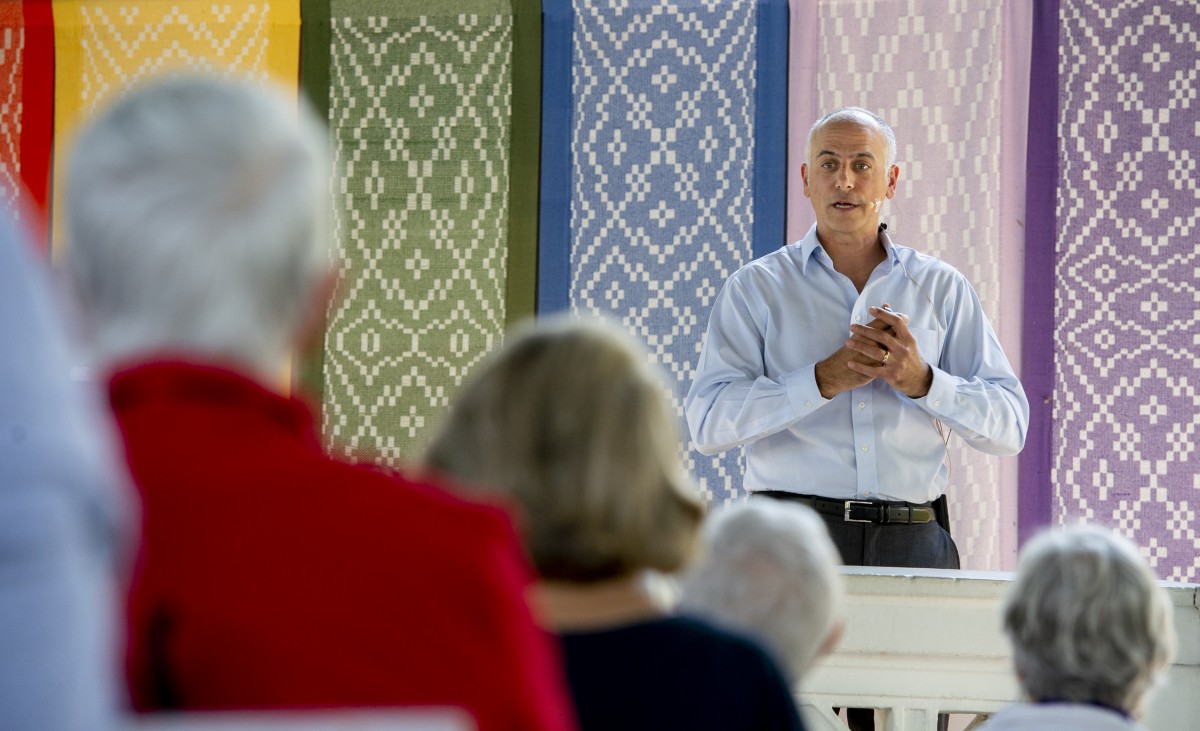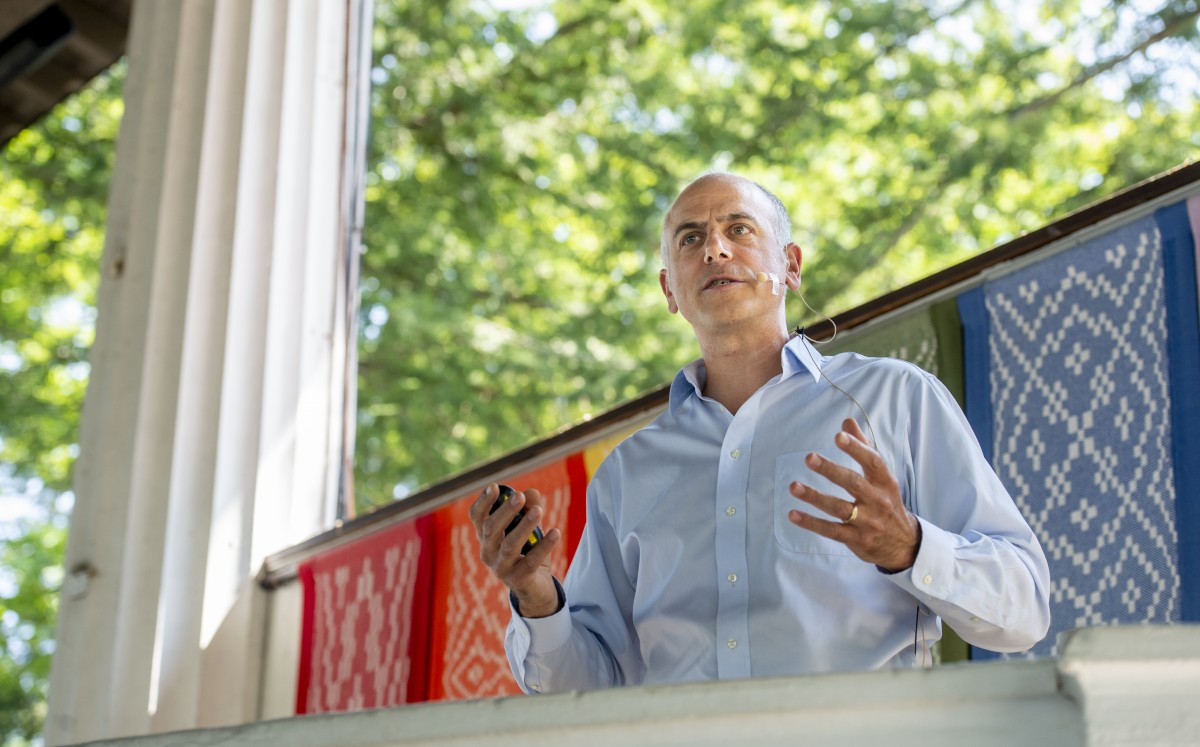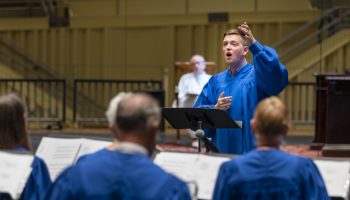Dan Habib has produced award-winning documentaries and garnered Emmy nominations, but he might have never become a filmmaker if not for his son Samuel Habib’s disability. When Samuel was born with a mitochondrial disease that led to cerebral palsy, Habib began making films that deal with disability advocacy.
“All my films, every day of my life — it’s all somehow motivated by Samuel in terms of the work that I do around disability rights and filmmaking.”
– Dan Habib, Director, “Including Samuel”
It was Samuel’s doctor that urged Habib — an accomplished photojournalist — to document his own family’s experience of disability through photography. Shortly afterwards, a group of teenagers convinced Habib that video would be a more powerful medium for the Habib family’s story. He turned the project into a documentary and has been making films about disability ever since.
At 2 p.m. Thursday, Aug. 23, in the Hall of Philosophy, Habib delivered his lecture “Disabling Segregation.” Habib drew on research, personal experience and his son’s life to argue that children with disabilities can and should experience regular developmental environments instead of being sequestered in programs like “special education.”
Habib, now with the University of New Hampshire’s Institute on Disability, has been involved with social justice since his days as an undergraduate at the University of Michigan. There, he said, he was a photographer for the school newspaper and participated in anti-apartheid and anti-racist movements — but not in any disability rights movements.
“I never heard the words ‘disability rights’ or ‘disability advocacy’ or ‘inclusive education’ in all the human rights and social justice issues of the time, back in ‘83 through ‘87,” Habib said. “I never heard about disability, and I almost never saw people with at least visual disabilities on campus.”
Habib said his current involvement in disability rights is mostly due to his son’s condition, but he also pointed to the country’s historically negative treatment of those with disabilities as a motivating factor. For example, from the 1920s until the 1970s, he said, the eugenics movement led to the forced sterilization of 60,000 people in the United States.
“I think that historical context is important, because it’s like the Black Lives Matter movement — if you don’t know that we’re a country with a history of racism and slavery, you don’t really get why that movement exists.”
Habib’s first film, “Including Samuel,” depicts the Habib family as they work to include Samuel — who uses a wheelchair to move and a speech device to communicate — in their lives and community.
Habib said they thought it was particularly important to make sure Samuel felt included in school, where enormous emotional and social growth takes place for American children. According to Habib, the efforts to include Samuel were not trivial — they were critical in his journey toward independence and adulthood.
“We know through 30 years of research that kids with disabilities who are included in regular education end up with better communication skills, higher academic achievement, wider social networks, fewer behavioral problems, more opportunity for higher education and more meaningful employment as adults,” he said.
Habib held up his son as evidence that inclusion leads to a better life. Samuel is now 18, freshly graduated from high school. He had a weekly sports segment on the school’s TV news, went to prom, and will be attending college this fall.
At many steps along Samuel’s journey, his community came together to make him feel like he belonged, Habib said. In one anecdote, Habib described Samuel’s involvement in his school’s production of Guys and Dolls.
“He was able to knock the dice off of his lap and say his lines using his communication device, Habib said. “Nobody batted an eye, because that’s just the way Sam would roll. In fact, the stage at the time was not wheelchair-accessible, so Sam and another girl named Hannah who also used a wheelchair had to enter the back of the stage using an old lift.”
Unfortunately, the lift made a squeaking noise that would interrupt the play.
“So,” Habib said, “the community came together, and they decided to build two ramps on either side of the front of the stage so that Samuel and Hannah could come up in front.”
Through that and other acts of community support, Samuel was able to participate in activities from baseball to Boy Scouts. According to Habib, Samuel grew up feeling a sense of belonging in his community.
If the research is any guide, that sense of belonging has contributed to Samuel’s present successes. But it’s not just Samuel who benefited from having the community, Habib said — the community also benefited from having a person with disabilities in its ranks.
For example, Habib said the ramps in Guys and Dolls let Samuel and Hannah get on stage, but other actors also used those access points, adding another dimension to the play’s staging. And when a refugee who didn’t speak English joined Samuel’s class in elementary school, his teacher said the students were better able to welcome her because they already had practice dealing with Samuel’s disabilities.
Research supports that conclusion, too. Habib said a study from a researcher at Vanderbilt University compared groups of students without disabilities to integrated groups made of students both with and without disabilities.
The study found that the able-bodied students who were in the integrated groups consistently scored higher than the students who were in the groups without students with disabilities. Habib explained that this was because the able-bodied students in the integrated groups would help the students with disabilities. By reteaching the material to those with disabilities, the able-bodied students were learning it more thoroughly.
Unfortunately, Habib said, not all educational environments are integrated like Samuel’s was. In the early ‘90s, Habib reported a photo story on a boy in their community named Todd. Todd, too, had a disability.
“Todd, through elementary school, which happened to be the same elementary school that Samuel went to, was fully included in a regular education. And he loved it,” Habib said. “He was so excited to go to school, and I know this because we were neighbors with this family as well.”
But in middle school, Todd was sequestered in a separate classroom for all of the students with disabilities. At the time, Todd didn’t have access to communication technology like Samuel had. Todd couldn’t communicate or express himself effectively until he was 21, when he did finally get a communication device.
“The first thing (Todd) said, he typed out, ‘F— you,’ ” Habib said.
According to Habib, Todd went on to say how angry he was for being deprived a sense of belonging in his community and not being able to participate in the regular educational community.
“That’s the flip side of Samuel’s experience,” Habib said. “And I know because I know this man to this day. Todd has had a really hard time adjusting to adulthood — no work, no higher education — because he never had that experience. And unfortunately, Todd’s experience is more representative of what we know about this country than Samuel’s.”
Habib went on to say that 56 percent of American kids with intellectual disabilities are segregated in schools, and only 17 percent of kids with those disabilities are “meaningfully included in regular education.” That’s despite the research that suggests that these students would do better if they were included, Habib said.
In addition to “Including Samuel,” Habib has also produced other films about disability such as “Who Cares about Kelsey?” and “Mr. Connolly Has ALS,” the latter of which features the story of Gene Connolly — the principal of Samuel’s high school — and his battle with ALS. Connolly died on Aug. 19.
Habib said his newest project, “Intelligent Lives,” explores perceptions of intelligence and follows three young people with disabilities in high school, college, and the workforce. “Intelligent Lives” will be released in September 2018.








